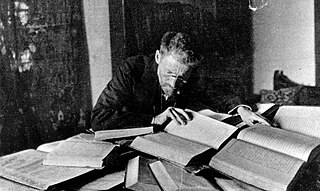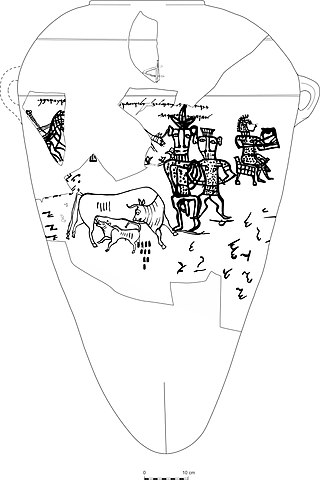The Hebrew alphabet, known variously by scholars as the Ktav Ashuri, Jewish script, square script and block script, is traditionally an abjad script used in the writing of the Hebrew language and other Jewish languages, most notably Yiddish, Ladino, Judeo-Arabic, and Judeo-Persian. In modern Hebrew, vowels are increasingly introduced. It is also used informally in Israel to write Levantine Arabic, especially among Druze. It is an offshoot of the Imperial Aramaic alphabet, which flourished during the Achaemenid Empire and which itself derives from the Phoenician alphabet.

The history of ancient Israel and Judah spans from the early appearance of the Israelites in Canaan's hill country during the late second millennium BCE, to the establishment and subsequent downfall of the two Israelite kingdoms in the mid-first millennium BCE. This history unfolds within the Southern Levant during the Iron Age. The earliest documented mention of "Israel" as a people appears on the Merneptah Stele, an ancient Egyptian inscription dating back to around 1208 BCE. Archaeological evidence suggests that ancient Israelite culture evolved from the pre-existing Canaanite civilization. During the Iron Age II period, two Israelite kingdoms emerged, covering much of Canaan: the Kingdom of Israel in the north and the Kingdom of Judah in the south.

Canaan was a Semitic-speaking civilization and region of the Southern Levant in the Ancient Near East during the late 2nd millennium BC. Canaan had significant geopolitical importance in the Late Bronze Age Amarna Period as the area where the spheres of interest of the Egyptian, Hittite, Mitanni, and Assyrian Empires converged or overlapped. Much of present-day knowledge about Canaan stems from archaeological excavation in this area at sites such as Tel Hazor, Tel Megiddo, En Esur, and Gezer.

The Israelites were a Hebrew-speaking ethnoreligious group consisting of tribes that inhabited much of Canaan during the Iron Age.

Baal, or Baʻal, was a title and honorific meaning 'owner' or 'lord' in the Northwest Semitic languages spoken in the Levant during antiquity. From its use among people, it came to be applied to gods. Scholars previously associated the theonym with solar cults and with a variety of unrelated patron deities, but inscriptions have shown that the name Ba'al was particularly associated with the storm and fertility god Hadad and his local manifestations.

Hadad, Haddad, Adad, or Iškur (Sumerian) was the storm and rain god in the Canaanite and ancient Mesopotamian religions. He was attested in Ebla as "Hadda" in c. 2500 BCE. From the Levant, Hadad was introduced to Mesopotamia by the Amorites, where he became known as the Akkadian (Assyrian-Babylonian) god Adad. Adad and Iškur are usually written with the logogram 𒀭𒅎dIM—the same symbol used for the Hurrian god Teshub. Hadad was also called Pidar, Rapiu, Baal-Zephon, or often simply Baʿal (Lord), but this title was also used for other gods. The bull was the symbolic animal of Hadad. He appeared bearded, often holding a club and thunderbolt and wearing a bull-horned headdress. Hadad was equated with the Greek god Zeus, the Roman god Jupiter, as well as the Babylonian Bel.

The Jebusites were, according to the books of Joshua and Samuel from the Hebrew Bible, a Canaanite tribe that inhabited Jerusalem, called Jebus before the conquest initiated by Joshua and completed by King David, although a majority of scholars agree that the Book of Joshua holds little historical value for early Israel and most likely reflects a much later period. 1 Chronicles 11:4 states that Jerusalem was known as Jebus before this event. The identification of Jebus with Jerusalem is sometimes disputed by scholars. According to some biblical chronologies, the city was conquered by King David in 1003 BC.

Israeli literature is literature written in the State of Israel by Israelis. Most works classed as Israeli literature are written in the Hebrew language, although some Israeli authors write in Yiddish, English, Arabic and Russian.
The Canaanite languages, sometimes referred to as Canaanite dialects, are one of four subgroups of the Northwest Semitic languages, the others being the still living Aramaic, Ugaritic and Amorite. These closely related languages originate in the Levant and Mesopotamia, and were spoken by the ancient Semitic-speaking peoples of an area encompassing what is today, Israel, Jordan, the Sinai Peninsula, Lebanon, Syria, as well as some areas of southwestern Turkey (Anatolia), western and southern Iraq (Mesopotamia) and the northwestern corner of Saudi Arabia. From the 9th century BC they also spread to the Iberian Peninsula,North Africa and Mediterranean in the form of Phoenician.
Idolatry in Judaism is prohibited. Judaism holds that idolatry is not limited to the worship of an idol itself, but also worship involving any artistic representations of God. The prohibition is epitomized by the first two "words" of the decalogue: I am the Lord thy God, Thou shalt have no other gods before me, and Thou shalt not make unto thee any graven image or any image in the sky, on earth or in the sea. These prohibitions are re-emphasized repeatedly by the later prophets, suggesting the ongoing appeal of Canaanite religion and syncretic assimilation to the ancient Israelites.
Over recorded history, there have been many names of the Levant, a large area in the Near East, or its constituent parts. These names have applied to a part or the whole of the Levant. On occasion, two or more of these names have been used at the same time by different cultures or sects. As a natural result, some of the names of the Levant are highly politically charged. Perhaps the least politicized name is Levant itself, which simply means "where the sun rises" or "where the land rises out of the sea", a meaning attributed to the region's easterly location on the shore of the Mediterranean Sea.
Proto-Canaanite is the name given to the
High places are simple hilltop installations with instruments of religion: platforms, altars, standing stones, and cairns are common. Along with open courtyard shrines and sacred trees or groves, they were some of the most often-seen public places of piety in the ancient Near East. They appear in the early Bronze Age at the latest.
Ancient Semitic religion encompasses the polytheistic religions of the Semitic peoples from the ancient Near East and Northeast Africa. Since the term Semitic represents a rough category when referring to cultures, as opposed to languages, the definitive bounds of the term "ancient Semitic religion" are only approximate but exclude the religions of "non-Semitic" speakers of the region such as Egyptians, Elamites, Hittites, Hurrians, Mitanni, Urartians, Luwians, Minoans, Greeks, Phrygians, Lydians, Persians, Medes, Philistines and Parthians.

Canaanite religion was a group of ancient Semitic religions practiced by the Canaanites living in the ancient Levant from at least the early Bronze Age to the first centuries CE. Canaanite religion was polytheistic and in some cases monolatristic. It was influenced by neighboring cultures, particularly ancient Egyptian and Mesopotamian religious practices. The pantheon was headed by the god El and his consort Asherah, with other significant deities including Baal, Anat, Astarte, and Mot.

Milcom or Milkom was the name of either the national god, or a popular god, of the Ammonites. He is attested in the Hebrew Bible and in archaeological finds from the former territory of Ammon. His connections to other deities with similar names attested in the Bible and archaeologically are debated, as well as his relationship to the Canaanite supreme deity El, or the putative deity Moloch.
Northwest Semitic is a division of the Semitic languages comprising the indigenous languages of the Levant. It emerged from Proto-Semitic in the Early Bronze Age. It is first attested in proper names identified as Amorite in the Middle Bronze Age. The oldest coherent texts are in Ugaritic, dating to the Late Bronze Age, which by the time of the Bronze Age collapse are joined by Old Aramaic, and by the Iron Age by Sutean and the Canaanite languages.
Shuah is the name of one of four minor Biblical figures. It is sometimes used as the name of a fifth. Their names are different in Hebrew, but they were all transliterated as "Shuah" in the King James Version.

Canaanism was a cultural and ideological movement founded in 1939, reaching its peak among the Jews of Mandatory Palestine during the 1940s. It has had a significant effect on the course of Israeli art, literature and spiritual and political thought. Its adherents were called Canaanites. The movement's original name was the Council for the Coalition of Hebrew Youth or less formally, the Young Hebrews; Canaanism was originally a pejorative term. It grew out of Revisionist Zionism and had roots in European extreme right-wing movements, particularly Italian fascism. Most of its members were part of the Irgun or Lehi.

Yahwism, as it is called by modern scholars, was the religion of ancient Israel and Judah. An ancient Semitic religion of the Iron Age, Yahwism was essentially polytheistic and had a pantheon, with various gods and goddesses being worshipped by the Israelites. At the head of this pantheon was Yahweh, held in an especially high regard as the two Israelite kingdoms' national god. Some scholars hold that the goddess Asherah was worshipped as Yahweh's consort, though other scholars disagree. Following this duo were second-tier gods and goddesses, such as Baal, Shamash, Yarikh, Mot, and Astarte, each of whom had their own priests and prophets and numbered royalty among their devotees.










